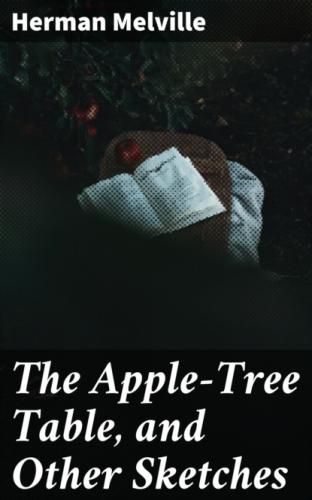The Apple-Tree Table, and Other Sketches. Herman Melville
tion>
Herman Melville
The Apple-Tree Table, and Other Sketches
Published by Good Press, 2019
EAN 4057664634023
Table of Contents
OR ORIGINAL SPIRITUAL MANIFESTATIONS
BY A VIRGINIAN SPENDING JULY IN VERMONT
THE PARADISE OF BACHELORS AND THE TARTARUS OF MAIDS
OR THE CROWING OF THE NOBLE COCK BENEVENTANO
POOR MAN'S PUDDING AND RICH MAN'S CRUMBS
Poor Man's Pudding
Rich Man's Crumbs
THE APPLE-TREE TABLE
OR ORIGINAL SPIRITUAL MANIFESTATIONS
When I first saw the table, dingy and dusty, in the furthest corner of the old hopper-shaped garret, and set out with broken, be-crusted old purple vials and flasks, and a ghostly, dismantled old quarto, it seemed just such a necromantic little old table as might have belonged to Friar Bacon. Two plain features it had, significant of conjurations and charms—the circle and tripod; the slab being round, supported by a twisted little pillar, which, about a foot from the bottom, sprawled out into three crooked legs, terminating in three cloven feet. A very satanic-looking little old table, indeed.
In order to convey a better idea of it, some account may as well be given of the place it came from. A very old garret of a very old house in an old-fashioned quarter of one of the oldest towns in America. This garret had been closed for years. It was thought to be haunted; a rumor, I confess, which, however absurd (in my opinion), I did not, at the time of purchasing, very vehemently contradict; since, not improbably, it tended to place the property the more conveniently within my means.
It was, therefore, from no dread of the reputed goblins aloft, that, for five years after first taking up my residence in the house, I never entered the garret. There was no special inducement. The roof was well slated, and thoroughly tight. The company that insured the house, waived all visitation of the garret; why, then, should the owner be over-anxious about it?—particularly, as he had no use for it, the house having ample room below. Then the key of the stair-door leading to it was lost. The lock was a huge old-fashioned one. To open it, a smith would have to be called; an unnecessary trouble, I thought. Besides, though I had taken some care to keep my two daughters in ignorance of the rumor above-mentioned, still, they had, by some means, got an inkling of it, and were well enough pleased to see the entrance to the haunted ground closed. It might have remained so for a still longer time, had it not been for my accidentally discovering, in a corner of our glen-like, old, terraced garden, a large and curious key, very old and rusty, which I at once concluded must belong to the garret-door—a supposition which, upon trial, proved correct. Now, the possession of a key to anything, at once provokes a desire to unlock and explore; and this, too, from a mere instinct of gratification, irrespective of any particular benefit to accrue.
Behold me, then, turning the rusty old key, and going up, alone, into the haunted garret. It embraced the entire area of the mansion. Its ceiling was formed by the roof, showing the rafters and boards on which the slates were laid. The roof shedding the water four ways from a high point in the centre, the space beneath was much like that of a general's marquee—only midway broken by a labyrinth of timbers, for braces, from which waved innumerable cobwebs, that, of a summer's noon, shone like Bagdad tissues and gauzes. On every hand, some strange insect was seen, flying, or running, or creeping, on rafter and floor.
Under the apex of the roof was a rude, narrow, decrepit step-ladder, something like a Gothic pulpit-stairway, leading to a pulpit-like platform, from which a still narrower ladder—a sort of Jacob's ladder—led somewhat higher to the lofty scuttle. The slide of this scuttle was about two feet square, all in one piece, furnishing a massive frame for a single small pane of glass, inserted into it like a bull's-eye. The light of the garret came from this sole source, filtrated through a dense curtain of cobwebs. Indeed, the whole stairs, and platform, and ladder, were festooned, and carpeted, and canopied with cobwebs; which, in funereal accumulations, hung, too, from the groined, murky ceiling, like the Carolina moss in the cypress forest. In these cobwebs, swung, as in aerial catacombs, myriads of all tribes of mummied insects.
Climbing the stairs to the platform, and pausing there, to recover my breath, a curious scene was presented. The sun was about half-way up. Piercing the little sky-light, it slopingly bored a rainbowed tunnel clear across the darkness of the garret. Here, millions of butterfly moles were swarming. Against the sky-light itself, with a cymbal-like buzzing, thousands of insects clustered in a golden mob.
Wishing to shed a clearer light through the place, I sought to withdraw the scuttle-slide. But no sign of latch or hasp was visible. Only after long peering, did I discover a little padlock, imbedded, like an oyster at the bottom of the sea, amid matted masses of weedy webs, chrysalides, and insectivorous eggs. Brushing these away, I found it locked. With a crooked nail, I tried to pick the lock, when scores of small ants and flies, half-torpid, crawled forth from the keyhole, and, feeling the warmth of the sun in the pane, began frisking around me. Others appeared. Presently, I was overrun by them. As if incensed at this invasion of their retreat, countless bands darted up from below, beating about my head, like hornets. At last, with a sudden jerk, I burst open the scuttle. And ah! what a change. As from the gloom of the
